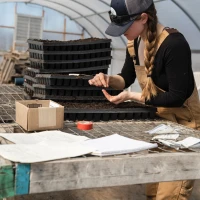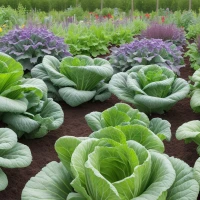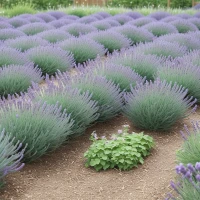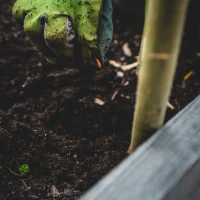Are you looking to enhance your garden’s vigor and yield? Mastering the ancient practice of companion planting, particularly with nutrient-rich spinach, can be your gateway to a flourishing garden. Understanding the synergistic relationships between plants is a crucial aspect of organic gardening, ensuring a bountiful harvest. Spinach, an extremely versatile and fast-growing leafy green, makes an excellent companion in the vegetable patch. In this extensive guide, we’ll delve deep into the art of companion planting with spinach, providing you with the knowledge to perfect your gardening game and unlock a new level of productivity within your tranquil green space.
Understanding Companion Planting: The Basics
Before we dive into specifics, let’s get a grasp of what companion planting entails and its manifold benefits.
Companion planting is a time-tested gardening method that pairs certain plants together to enhance growth, deter pests, and maximize the use of space and nutrients. This method is not just a folklore add-on; it’s rooted in scientific principles and observations.
The Benefits of Companion Planting Spinach
- Improved Pest Control: Certain plants can naturally repel pests that would otherwise be attracted to your spinach.
- Enhanced Soil Health: Companion plants can help improve the structure and fertility of the soil, creating a nutrient-dense haven for your greens.
- Optimal Space Utilization: Planting compatible species together means you can get the most out of every square inch of your garden.
- Natural Support and Shelter: Some taller companion plants provide shade and support for spinach, which thrives in cooler temperatures.
Spinach Companion Planting: The Ultimate Guide
Now let’s focus on spinach and its companions. This leafy green is not just a powerhouse of nutrients for us but also a valuable ally in the garden. Below you will find comprehensive strategies and specific plant partners that can optimize spinach’s growth.
Best Companion Plants for Spinach
Discover plants that share a symbiotic relationship with spinach and how they contribute to a more productive garden.
Leafy Greens and Herbs: The Spice of Life
Spinach pairs wonderfully with a variety of greens and herbs. Each of these companions supports spinach in different ways:
- Lettuce: Share similar growing conditions, create a diverse polyculture that is less appealing to pests.
- Chard: Complements spinach’s nutrient uptake without competing for resources.
- Arugula: Quite the duo, these greens can be harvested simultaneously for a mixed salad straight from the garden.
- Dill: Attracts beneficial insects and can deter pests that target spinach.
- Cilantro: Its strong aroma can mask the scent of spinach, throwing off unwanted insects.
Cruciferous Vegetables: A Garden’s Best Defense
These robust plants are not just healthy additions to your diet; they add a layer of protection for your spinach.
- Broccoli: This garden favorite helps to repel pests with its strong odor, acting as a line of defense for your spinach.
- Cauliflower: Similarly to broccoli, its presence can deter pests from homing in on your spinach.
Nightshades: Proceed with Caution
While some plants benefit from the presence of spinach, nightshade plants like tomatoes and peppers may not be the best bedfellows. They can attract pests and diseases that are harmful to spinach.
Spinach’s Unfavorable Companions: What to Avoid
Certain plants should be kept at a distance from your spinach patch to avoid nutrient competition, space conflicts, or pest attraction:
- Potatoes: Hefty feeders that can deplete the soil of nutrients needed for your spinach to thrive.
- Onions: Although beneficial in pest control, onions can stunt the growth of spinach with their extensive root systems.
Maximizing Spinach Growth: Companion Planting Strategies
Soil and Shade: Creating an Optimal Environment for Spinach
Embracing the Cool
Spinach favors cooler climates, making it essential to strategize your planting schedule:
- Plant alongside taller crops that can provide shade from the harsh midday sun.
- Incorporate mulch to keep the soil cool and retain moisture for your spinach.
Nutrient-Rich Soil
Foster a soil environment that will allow spinach and its companions to flourish:
- Integrate organic compost or a slow-release fertilizer to enhance soil fertility without overwhelming your spinach.
Succession Planting: A Timely Approach
Companion Crop Rotation
Rotating different groups of companions in and out of the spinach patch keeps the soil lively and rich:
- Follow a leafy green with a legume or brassica to ensure a diverse nutrient profile in the garden bed.
Seasonal Timing
Plant spinach in early spring or late summer to sidestep the peak heat of summer, which can cause it to bolt:
- Plan your companion planting schedule to have mature plants ready to provide shade when the temperatures rise.
Cultivating a Pest-Free Garden with Spinach Companions
Organic Pest Control Methods
Companion planting is an ideal strategy for natural pest management. By interspersing certain plants, you can sidestep the need for harmful chemicals.
Attracting Beneficial Insects
- Plant flowers like marigolds or nasturtiums: They pull in predatory insects that feast on common spinach pests.
Herb Sentry
- Strong-scented herbs: These act as olfactory camouflage, protecting spinach from pest invasions.
The Role of Spinach in Integrated Pest Management (IPM)
Spinach can play a part in a bigger pest control strategy, becoming part of a healthy, pest-resistant polyculture.
Trap Cropping
- Use spinach as a sacrificial plant in some cases to attract pests away from more sensitive crops.
Providing Year-Round Care for Spinach and Companions
Seasonal Spinach Care Tips
Different seasons call for varied care strategies to keep your companion plants thriving.
Spring Awakening
- Spring planting: Protect young spinach from late frosts with row covers or plant under taller companions that can buffer the cold.
Summer Vigilance
- Shade and water are crucial as temperatures climb to prevent spinach from bolting too quickly.
Autumn Harvest
- Great time for a second planting of spinach, use companion strategy to extend the harvest period into the cooler months.
Winter Planning
- In temperate climates, spinach can overwinter under protective cover, plan your garden layout for the coming year.
Advanced Companion Planting Techniques: Beyond the Basics
Companion Plant Interplanting and Stacking
Vertical Space Utilization
Climbing plants can be paired with low-growing spinach to maximize garden space and productivity.
Root Depth Variation
- Intersperse plants with different root depths to prevent competition and promote complementary nutrient uptake.
Companion Plant Nutrition Synergies
- Learn which companion plants add nutrients to the soil that spinach can benefit from, such as legumes that fix nitrogen.
The Ecological Impact of Companion Planting Spinach
Companion planting isn’t just about plant relationships; it’s about fostering a micro-ecosystem within your garden.
Building a Resilient Garden Ecosystem
- Plant diversification is vital for soil health, pest control, and overall environmental resilience.
Encouraging Biodiversity
- A companion-planted garden with spinach invites a myriad of insects, birds, and other wildlife, strengthening the garden’s natural defenses.
Conclusion: Reap the Rewards of Companion Planting with Spinach
As you embark on your journey into companion planting with spinach, embrace the tried-and-true with the newfound wisdom you’ve gained. Use these strategies to transform your garden into a symphony of cooperative growth, where each plant plays its part in the grand orchestration of your green haven. Armed with this knowledge, you can elevate the productivity and health of your garden, creating a sustainable, bountiful, and beautiful space that provides not just food but joy and a connection to the earth.
Remember, whether a beginner or a seasoned green thumb, the journey of garden mastery is perpetual. Each season provides fresh insights and experiences. Let the delicate yet robust leaves of spinach guide you toward a more harmonious garden ecosystem, where the secrets of companion planting yield a harvest rich in vitality and splendor.










